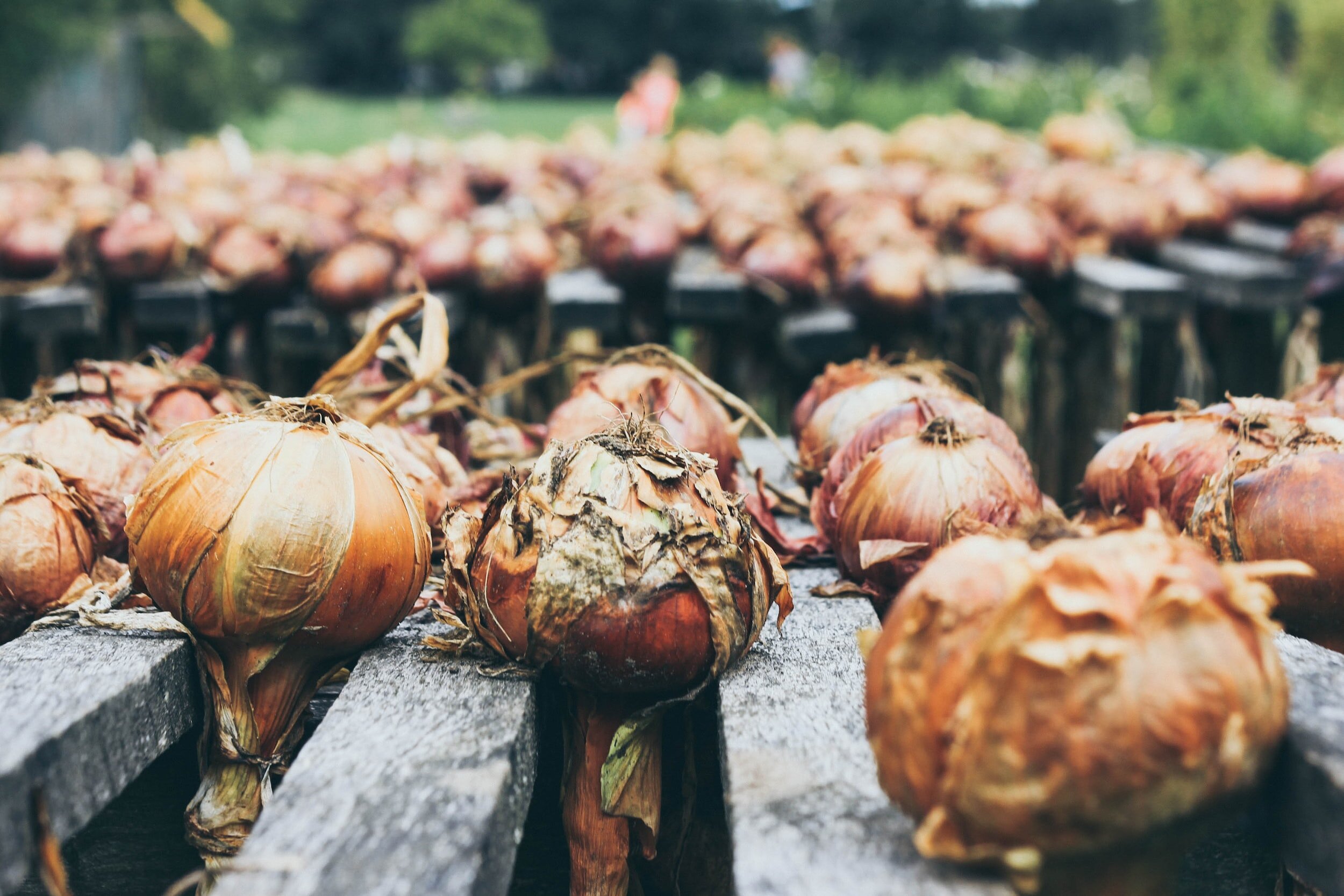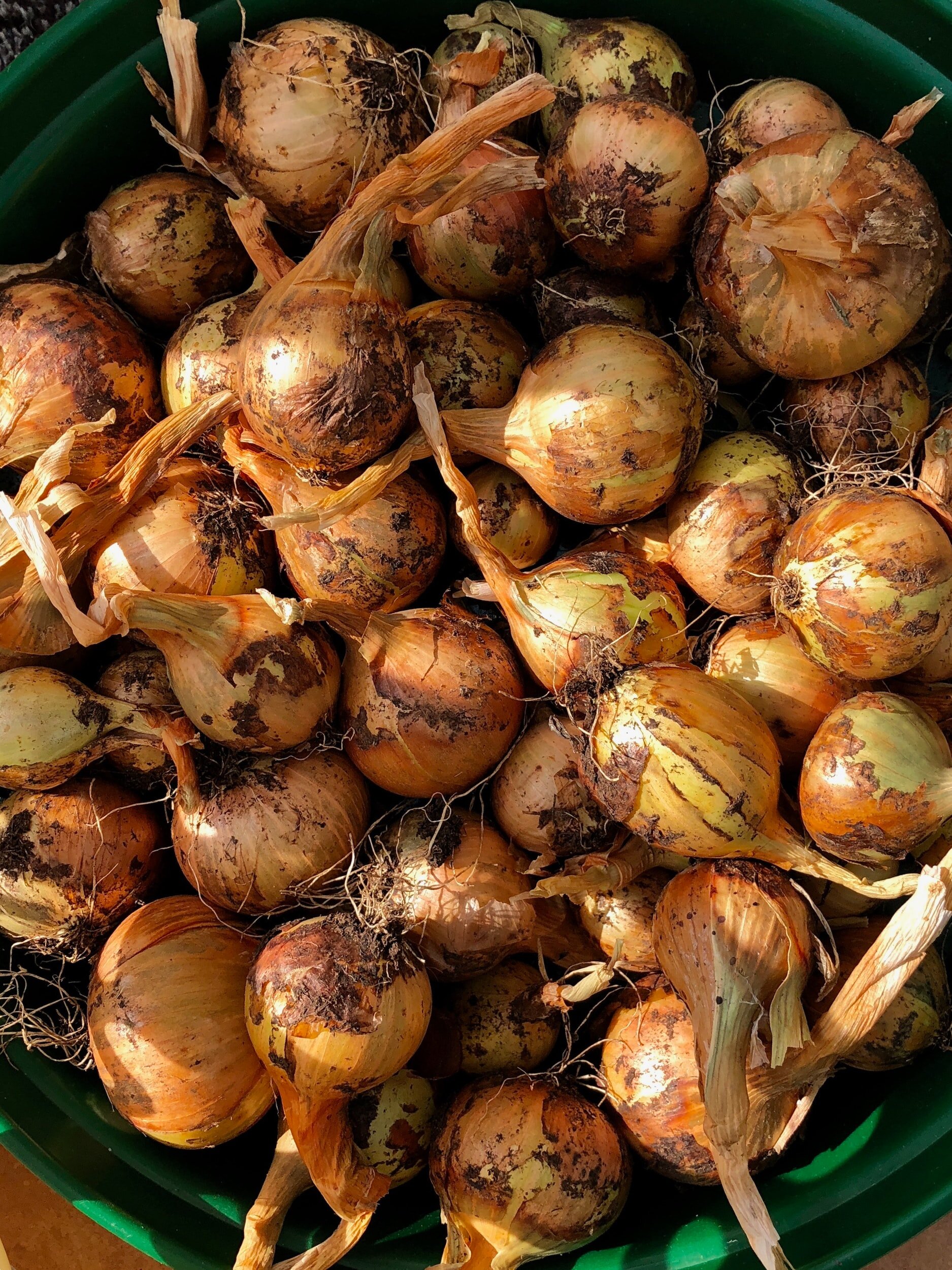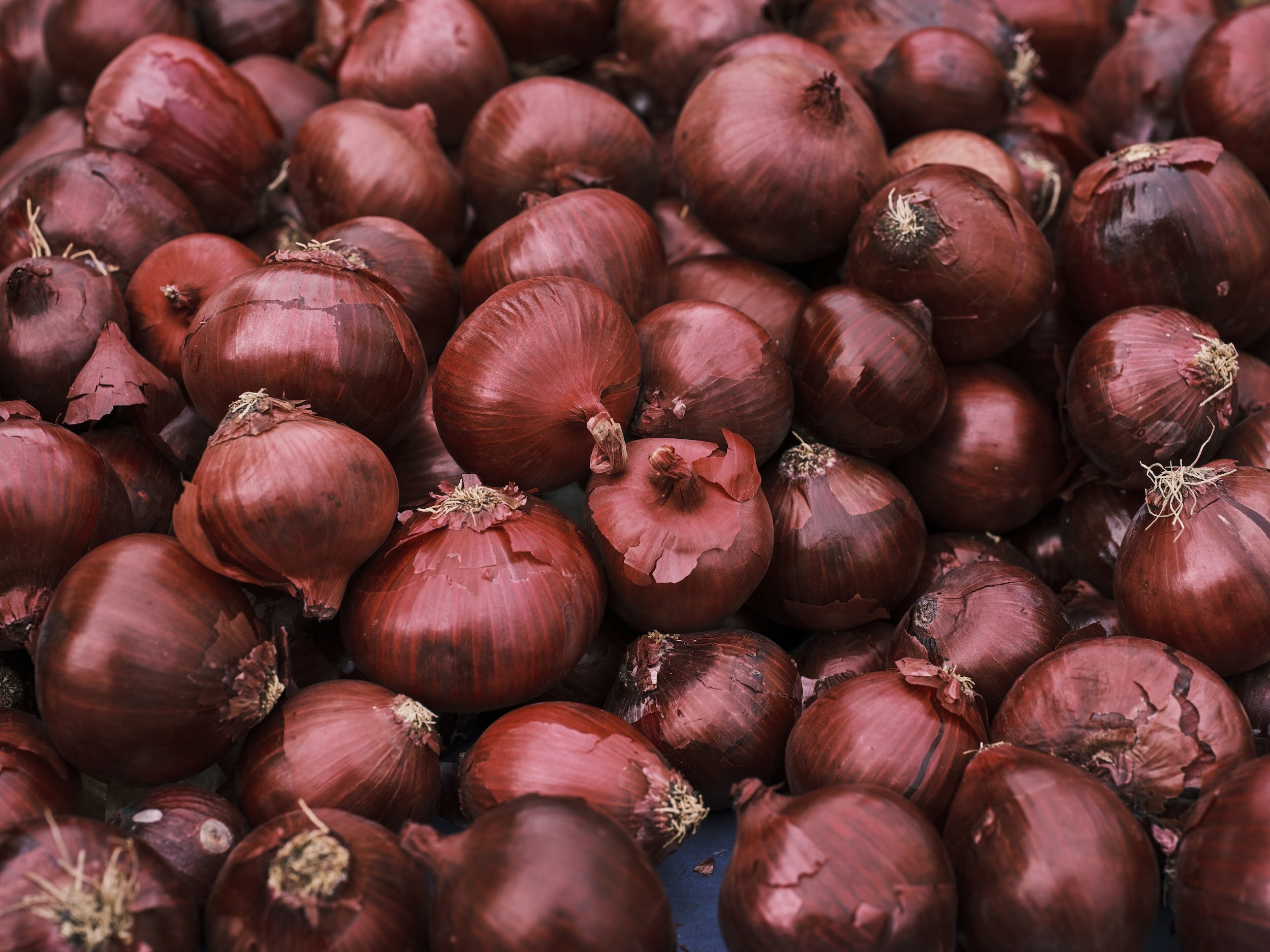BACKYARD GARDENING MADE SIMPLE
How To Grow, Harvest and Store Onions [Guide]
Growing onions at home is a rewarding endeavor. From the simple pleasure of harvesting your own crops to the ability to customize flavors in your favorite recipes, the journey of growing onions offers a delightful experience for any gardening enthusiast. Get ready to savor the distinct flavors and enjoy the convenience of having these versatile vegetables right at your fingertips.
Onions, with their pungent aroma and distinct flavor, are a staple ingredient in countless cuisines around the world. These versatile vegetables not only add depth and complexity to dishes but also offer a range of health benefits. Whether you prefer the mild sweetness of a Vidalia onion or the sharp bite of a red onion, growing your own onions at home can elevate your culinary experiences to new heights.
In addition to their culinary appeal, onions also provide numerous health benefits. They are rich in antioxidants, vitamins, and minerals that support overall well-being. Onions are known for their anti-inflammatory properties, cardiovascular benefits, and potential cancer-fighting compounds. Incorporating fresh, homegrown onions into your diet allows you to enjoy these nutritional advantages while savoring their incredible flavors.
So, whether you're an avid home cook looking to elevate your dishes or a health-conscious individual seeking the nutritional benefits of fresh produce, growing onions at home is a rewarding endeavor. From the simple pleasure of harvesting your own crops to the ability to customize flavors in your favorite recipes, the journey of growing onions offers a delightful experience for any gardening enthusiast. Get ready to savor the distinct flavors and enjoy the convenience of having these versatile vegetables right at your fingertips.
What Kind Of Onions Should You Grow?
When it comes to choosing onion varieties for your garden, there is a wide array of options available. Let's explore some popular onion varieties that are well-suited for home cultivation:
The 'Yellow Sweet Spanish' onion is a classic variety known for its large, golden bulbs. It has a mild and sweet flavor, making it a favorite for salads, sandwiches, and other raw preparations. With its globe-shaped bulbs and crisp texture, this variety is a versatile choice in the kitchen.
On the other hand, the 'Red Burgundy' onion offers a stunning deep-red color that adds visual appeal to any dish. It has a medium-sized bulb with a slightly milder taste compared to yellow onions. 'Red Burgundy' onions are perfect for grilling, roasting, or caramelizing, as they develop a rich and sweet flavor when cooked.
For those seeking a milder and sweeter onion, the 'White Lisbon' variety is an excellent option. These onions have a white or pale yellow skin and a delicate flavor. 'White Lisbon' onions are popular for their use in soups, stir-fries, and dishes where a subtle onion flavor is desired.
Long Day vs Short Day Onions
Onions are classified as either long-day or short-day varieties, based on their sensitivity to daylight hours. Long-day varieties, such as 'Yellow Sweet Spanish' and 'Red Burgundy,' require 14-16 hours of daylight to form bulbs. These varieties perform best in regions with longer daylight hours and cooler climates.
On the other hand, short-day varieties, like 'White Lisbon,' require 10-12 hours of daylight to form bulbs. These varieties are well-suited for regions with shorter daylight hours and warmer climates. It's crucial to choose the appropriate type of onion based on your location to ensure optimal bulb development.
Another factor to consider is the storage capability of the onion varieties. Some onions, like 'Yellow Sweet Spanish' and 'Red Burgundy,' have good storage potential and can be stored for several months under the right conditions. These varieties are ideal if you want to enjoy homegrown onions well into the winter months. 'White Lisbon' onions, on the other hand, are typically used and consumed fresh.
Where to Plant Onions
Onions thrive in full sun exposure, which is typically defined as at least 6-8 hours of direct sunlight per day. When selecting a site for growing onions, prioritize an area in your garden that receives ample sunlight throughout the day. The sunlight helps promote healthy growth, bulb development, and overall productivity of the onion plants.
Soil preparation is key to providing onions with the optimal growing conditions. Onions prefer well-draining soil that is rich in organic matter. Before planting, it's important to assess the soil's pH level. Onions generally prefer slightly acidic soil with a pH range of 6.0 to 7.5. You can adjust the soil pH by adding amendments like lime to raise the pH or sulfur to lower it. Conduct a soil test to determine the current pH level and make the necessary adjustments to create a favorable environment for onion growth.
In addition to pH adjustments, incorporating organic matter into the soil helps improve soil structure, drainage, and nutrient retention. Prior to planting onions, work compost or well-rotted manure into the soil to enrich it with organic matter. This practice not only enhances the soil's fertility but also supports healthy root development and bulb formation.
Onions require sufficient room to grow and spread their roots. Adequate spacing between plants allows for proper airflow, which helps prevent diseases and promotes healthy growth. Follow the recommended spacing guidelines provided for the specific onion variety you are planting.
Another important consideration is soil fertility. Select an area of your garden that has fertile soil or that has been amended with organic matter. Avoid areas with compacted soil or locations where water tends to accumulate, as these conditions can lead to poor onion growth and increased susceptibility to diseases.
Furthermore, pay attention to nearby plants and their compatibility with onions. Onions are known to have certain companion plants that can benefit their growth, such as carrots, beets, and lettuce. Avoid planting onions near plants that may compete for nutrients or inhibit their growth.
Growing Onions from Seed or Sets
There are two main methods for starting onions: from seeds or sets. Both methods have their advantages and considerations, so it's important to choose the one that suits your preferences and growing conditions.
Seed Onions
Starting onions from seeds offers a wider variety selection and is often more cost-effective. Seeds can be purchased from garden centers, online suppliers, or harvested from previous onion plants. This method allows you to choose from a diverse range of onion varieties, including those with specific flavor profiles, bulb shapes, and colors.
To start onions from seeds, begin by selecting a high-quality seed starting mix or create your own by combining equal parts of peat moss, vermiculite, and perlite. Fill seed trays or small containers with the seed starting mix. Sow the onion seeds thinly and evenly on the surface of the seed starting mix. Lightly press them into the soil, ensuring good seed-to-soil contact, but do not bury them too deeply. Cover the tray or container with a clear plastic lid or plastic wrap to create a greenhouse-like environment that retains moisture and warmth. This helps with seed germination. Place the trays or containers in a warm location with temperatures around 65-75°F (18-24°C). Ensure that the seeds receive adequate indirect light, either from a sunny windowsill or by using fluorescent lights. Keep the seed starting mix consistently moist but not waterlogged. Use a misting bottle or a gentle watering method to avoid dislodging the seeds.
Within 7-10 days, you should start seeing the onion seeds germinating. Once the seedlings have developed their first set of true leaves, they can be transplanted into individual pots or cell trays for further growth.
Onion Sets
Planting onion sets is a popular method for those who prefer a quicker start or live in regions with shorter growing seasons. Onion sets are small bulbs that have been grown from seeds the previous year and then harvested and stored. They are available in garden centers or through online suppliers.
To plant onion sets, choose firm and healthy onion sets that are free from mold or soft spots. Sets that are around 3/4 to 1 inch in diameter are ideal. Prepare the planting area by loosening the soil and removing any weeds or debris. Ensure the soil is well-draining and amended with compost or well-rotted organic matter. Dig a small hole or trench that is deep enough to accommodate the onion set. Place the set in the hole or trench with the pointed end facing up. Space the sets according to the recommended spacing for the specific variety you are planting. Typically, sets are spaced 4-6 inches apart in rows that are 12-18 inches apart. Gently backfill the soil around the sets, ensuring that they are covered to the neck, leaving only the tip exposed. Firmly press the soil around the sets to secure them in place. Water the newly planted sets thoroughly to settle the soil and encourage root development.
Onion sets have the advantage of providing a head start in the growing process since they have already gone through the initial stages of growth. They tend to mature earlier than onions started from seeds. However, they may have limited variety options compared to seeds, and some sets may have a higher risk of bolting or producing flowering stalks.
Caring for Onion Plants
Regular watering is crucial for the proper growth and development of onion plants. Onions require consistent moisture to promote bulb formation. However, it's important to strike a balance and avoid overwatering, as this can lead to rot and disease. Aim to keep the soil evenly moist, providing about 1 inch of water per week, including rainfall.
To determine when to water, monitor the soil moisture by inserting your finger about an inch into the soil. If it feels dry at that depth, it's time to water. Water deeply to encourage the roots to grow deeper into the soil. Avoid overhead watering, as it can increase the risk of fungal diseases. Instead, use a soaker hose or drip irrigation to deliver water directly to the soil.
Weed control is essential for onion plants as weeds can compete for nutrients, water, and sunlight. Weeds can also hinder proper airflow around the plants, increasing the risk of disease. Regularly inspect the onion bed and remove any weeds by hand, ensuring that you pull them out by the roots to prevent regrowth.
To minimize weed growth, you can apply a layer of organic mulch around the onion plants. This will help suppress weed growth and conserve soil moisture. Organic mulch options include straw, chopped leaves, or grass clippings. Apply a layer of mulch about 2-3 inches thick, making sure to keep it a few inches away from the onion stems to prevent excess moisture and potential rotting.
Onions benefit from regular fertilization to ensure healthy growth and bulb development. Before planting, it's recommended to prepare the soil by incorporating well-rotted compost or aged manure. This helps enrich the soil with essential nutrients and organic matter.
During the growing season, you can provide additional fertilizer to support onion growth. Use a balanced fertilizer, such as a 10-10-10 or 14-14-14, and follow the package instructions for application rates. Apply the fertilizer around the base of the plants, taking care not to let it come into direct contact with the leaves or bulbs.
Mulching offers several benefits when caring for onion plants. Firstly, it helps conserve soil moisture by reducing evaporation and preventing water runoff. This is especially important during hot and dry periods. Consistent soil moisture is essential for proper bulb development.
Secondly, mulch helps suppress weed growth by blocking sunlight and inhibiting weed seed germination. This reduces competition for nutrients, water, and light, allowing the onion plants to thrive.
Lastly, mulch acts as a natural insulator, regulating soil temperature. Onions prefer cooler soil temperatures, and mulch helps maintain a more stable environment, protecting the roots from extreme heat or cold.
Apply the mulch around the base of the onion plants once they have become established and the soil has warmed up. Replenish the mulch as needed to maintain the desired thickness and ensure its effectiveness throughout the growing season.
Onion Pests
Onion Thrips: These tiny insects feed on onion leaves, causing silvering or browning of the foliage. Severe infestations can lead to stunted growth and reduced bulb development.
Onion Maggots: The larvae of onion maggots feed on onion roots, leading to wilting, yellowing, and death of the plants. These maggots are typically found in the soil around the onion plants.
Aphids: These small insects can cluster on onion leaves, sucking sap and causing distortion and yellowing of the foliage. They can also transmit viral diseases to the plants.
When it comes to managing pests on onions, organic methods are often preferred to minimize the use of synthetic chemicals:
Row Covers: Use lightweight floating row covers to physically exclude pests like onion thrips. Cover the plants early in the season, securing the edges to prevent pests from entering. Be sure to remove the covers when the plants start to bulb and require pollination.
Beneficial Insects: Encourage beneficial insects like ladybugs, lacewings, and parasitic wasps that prey on pests like aphids and thrips. Planting flowers that attract these beneficial insects, such as marigolds or alyssum, can help attract and support them in your garden.
Natural Insecticides: If pest populations become overwhelming, you can use organic insecticides derived from natural sources, such as neem oil or insecticidal soap. Follow the instructions on the product labels for proper application and safety precautions.
Onion Diseases
Onion Downy Mildew: This fungal disease appears as yellow spots on the leaves, eventually turning the foliage brown. It thrives in cool, wet conditions. To prevent onion downy mildew, avoid overhead watering, promote good air circulation, and remove any infected plants promptly.
White Rot: White rot is a fungal disease that affects the roots and bulbs of onions. It causes white, fluffy fungal growth and can lead to the rotting of the bulbs. To prevent white rot, practice crop rotation, avoid planting onions in the same area for consecutive years, and ensure good soil drainage.
To manage diseases on onions, prevention is key. Here are some preventive measures:
Crop Rotation: Rotate your onion crops every year, preferably with plants from a different family, to reduce the risk of disease buildup in the soil.
Proper Sanitation: Clean up any debris or plant material from the garden, especially those infected with diseases. This helps prevent the spread and overwintering of pathogens.
Disease-resistant Varieties: Consider planting onion varieties that are known to have resistance to specific diseases prevalent in your area.
Harvesting Onions
To know when your onions are ready to harvest, look for yellowing and drying of the foliage, with the majority of leaves turning brown and falling over. This indicates that the bulbs have reached their full size and are ready for harvest. Before harvesting, stop watering the onions for a week or two. This helps the outer layers of the bulbs dry and prepare for storage.
Use a garden fork or shovel to gently loosen the soil around the onions, being careful not to damage the bulbs. Insert the tool a few inches away from the bulbs and lift them out of the ground. Once the onions are lifted, gently brush off excess soil, but avoid removing the outermost dry layers. The outer layers provide protection during storage.
How to Cure Onions
Curing onions is an important step to enhance their storage capabilities. Curing involves drying the onions further to toughen their outer layers, extend their shelf life, and develop their flavor. Place the harvested onions in a well-ventilated area with low humidity. A dry, shaded spot such as a garage or covered porch works well. Spread the onions out in a single layer, ensuring good airflow around each bulb. Avoid overcrowding, as this can lead to moisture buildup and potential rotting. Allow the onions to cure for 2 to 3 weeks. During this time, the outer layers will dry and harden, and the flavors will intensify. Once the onions are fully cured, gently remove any remaining soil or loose layers of dry skin. Trim the roots to about half an inch and cut the tops down to an inch above the bulb.
How to Store Onions
If you have long-stemmed onions, you can braid their tops together and hang them in a cool, dry place. This method allows for good airflow and easy access to individual onions.
For onions without long stems, you can tie them in mesh bags or pantyhose and hang them in a well-ventilated area. Make sure to keep the onions separate to prevent the spread of rot if one onion spoils.
If you have a cool and dry basement or cellar, you can store onions in mesh bags or crates. Keep them in a single layer, allowing airflow between the bulbs. Check periodically for any signs of spoilage and remove any affected onions.
Remember that onions are best stored away from potatoes, as they can release moisture and gasses that may cause each other to spoil faster.
Growing onions at home can be a rewarding experience, providing you with fresh, flavorful bulbs for your culinary creations. By choosing the right varieties, providing optimal growing conditions, and following proper care and harvesting techniques, you can enjoy a bountiful onion harvest. From planting to curing and storing, each step is essential for maximizing the quality and shelf life of your onions. So, get started on your onion garden and savor the satisfaction of growing your own delicious and versatile vegetable.

![How To Grow, Harvest and Store Onions [Guide]](https://images.squarespace-cdn.com/content/v1/60e85024dc86d643da81c96a/1687201638150-N1KZIAZOTV1KUE0DNE47/image-asset.jpeg)




